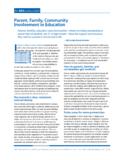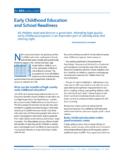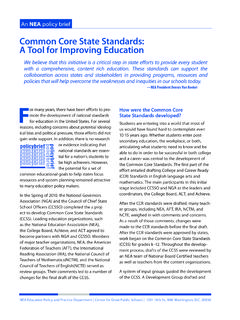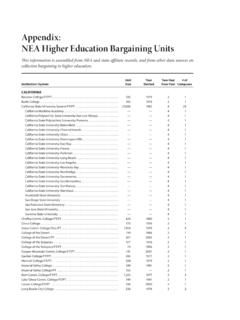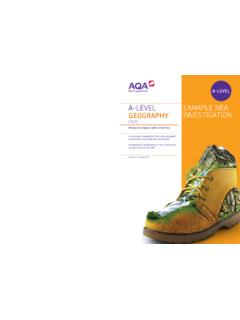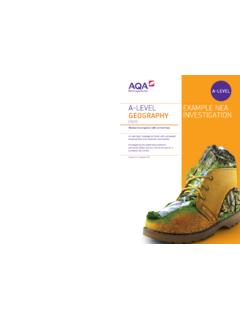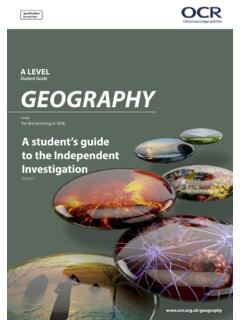Transcription of Technology in Schools: The Ongoing Challenge of …
1 NEA Education Policy and Practice Department | Center for Great Public Schools | 1201 16th St., NW, Washington, 20036 An NEA policy brief Great strides have been made in infusing Technology into schools and into the instructional process. school districts have invested heavily in the infra-structures required to accommodate computers and the Internet. They have commandeered resources to purchase software and technical support for students and staff, and they have mandated professional development for educators and administrators. Some have even established curriculum standards for Technology to ensure that students achieve a certain level of competency before they graduate. Yet, despite the overall progress, many schools are not making full use of Technology as a component of compre-hensive school reform.
2 The pace of implementation may be slow partly because of competing priorities, and partly because of the lack of reliable information, resources, and expertise on which to make decisions and guide imple-mentation. This policy brief is offered as a resource to help policymakers, researchers, and educators gain fur-ther insight into the issues of access, adequacy, and equity in education Technology , and to offer recommen-dations on how to ensure greater balance in the integra-tion of Technology in schools. Where are the computers?Although schools have made progress in bringing comput-ers and the Internet to students and staff, greater access is still needed in order for Technology to become a reliable tool for teaching and learning. Studies continue to docu-ment that the availability and quality of Technology is woe-fully inadequate in most classrooms, and most educators report their classroom is not the main location in the school where their students use Educators and policy-makers who advocate the learning of skills relevant to the 21st century strongly argue that literacy in information and communications Technology (ICT)
3 Which relies on skills such as thinking and problem solving, communicating effectively, self-direction and productivity requires fully integrating Technology with classroom A national count of computers in public schools shows a ratio of for the number of students sharing an instructional computer with Internet access3 but the data makes no distinctions between computers in the class-rooms and those in school Technology labs. All computers in the school are counted as being used for instructional purposes whether or not they are available for students use. Beyond that definition, the ratio does not reflect how computers are distributed across districts, schools, and classrooms of varying demographics. The state of Maryland, for example, reports that, on average, only 10 percent of classrooms in the state have five or more supplement classroom computers, districts are begin-ning to rely more upon portable and wireless computers that can be moved between classrooms and can be used outside of school by staff and students.
4 Districts across the country are beginning to seek public and private funds to buy more laptops, and they are looking to install wireless infrastructures that would permit more flexibility in the use of their school Technology . 5,6 Internet, software, and technical support are concernsProviding access to the Internet, as well as obtaining appro-priate software, are also issues for many educators, particu-larly those working with young students and those working in urban schools. Educators working in the early grades need increased access to the Internet, as well as more age-appropriate software for their students. This is Technology in Schools: The Ongoing Challenge of Access, Adequacy and EquityIf our children are to excel in a fast-changing, global society, we must harness the Technology resources they need to function in a digital age.
5 We must remember our commitment to their future as we set priorities and establish policies on their behalf. NEA President Dennis Van Roekel2 NEA Education Policy and Practice Department | Center for Great Public Schools | 1201 16th St., NW, Washington, 20036 An NEA policy brief An NEA policy brief especially important to districts that are paying particular attention to Technology in the early years, using an integra-tive approach to Technology whereby students build on their skills each year they progress through the grades. 7 Computer maintenance and upgrades are also a chal-lenge in many schools. Educators working in urban schools who have relied on the federal e-rate fund a program which provides discounts to assist public schools and libraries to obtain affordable telecommunica-tions and Internet access still must seek other resources to help upgrade software and to provide maintenance and support for their computers.
6 Educators in senior high schools, particularly in urban areas, need greater techni-cal support to help set up and use Technology in their Experts agree that maintenance capabilities and technical personnel make up a large part of the school Technology budget, but most often is not given the proper attention during the planning phase of bring-ing Technology Who s using Technology and for what?Although educators do get Technology training, most do not feel prepared to use Technology for instructional pur-poses, especially for individualized instruction. Educators in urban and rural schools are much less likely than subur-ban educators to feel adequately trained. 10 Some Technology advocates believe Technology training should be emphasized much earlier, during teacher educa-tion programs, but only 19 states have Technology require-ments as part of the licensing Experts further believe that teachers should know how to use tech-nology to deliver alternative kinds of pedagogy, such as inquiry learning, models, and simulations to help students develop higher-order thinking skills.
7 Here, students utilize Technology to become more involved in the construction of their knowledge rather than having all information flow from their teachers. However, such uses still are not com-mon, and the Technology standards that are in place for students or teachers are not being applied. Of the 48 states with Technology standards for students, only four test stu-dents on their knowledge of Technology . 12 Clearly, the full integration of Technology into teaching and learning is a multistep process that goes well beyond buying equip-ment and offering basic Technology training. The link between Technology and achievementEven with funding and policy limitations, several states and districts are engaging their students with a multitude of Technology -enriched curricula and instruction and are demonstrating positive links to student achievement in a variety of subjects.
8 13,14 Researchers are finding a clear link between Technology , achievement, and motivation. Most experts engaged in the Technology debate agree that stu-dents and teachers tend to be more engaged and inter-ested when Technology is an integral part of teaching and learning. For example, seventh- and eighth-grade students in Maine who received laptops are reported to be more engaged and able to produce higher quality work,15 while distance learning projects in several states (Florida, Virginia, New York, New Jersey, and Texas) have been found to fos-ter collaborative learning and student interest in science. 16 Most educators agree that Technology improves student learning, but the vast majority also believe their students enjoy learning more with Technology . Urban educators are particularly strong in their belief that Technology has a pos-itive impact on their for Technology has led many school districts to successfully alter not only the curriculum but also the way the curriculum is delivered.
9 By recent counts, at least 23 states are now operating virtual schools where students can receive instruction In Florida, almost 45,000 stu-dents in grades 6 12 take courses online from the Virtual school , and Michigan became the first state to pass a law mandating that high school students have at least one online learning experience to graduate. Rural and small town schools are now able to use videoconferencing and the Web to provide courses in subjects where a local teacher is not available, and some districts now offer services at home to some students with In fact, the growth in online learning prompted NEA and other organizations to work together to develop guidelines for course The guidelines are intended to help students, par-ents, teachers, and school administrators create, use, and even assess online courses.
10 Technology also has a significant effect on the quality of the work experience for classroom teachers. While teachers are generally positive about Technology , newer teachers are even more enthusiastic. More of them are satisfied with their general knowledge of Technology and see it as hav-ing an impact on their job effectiveness. Studies show that when educators use Technology they feel they are able to do their job more Also, while most educators agree that Technology is essential to teaching and learning, educators in urban and rural/small town schools are more likely to agree strongly about the value of Technology for them and their Perhaps the value of Technology in urban and rural schools rests mostly with its usefulness 3 NEA Education Policy and Practice Department | Center for Great Public Schools | 1201 16th St.
